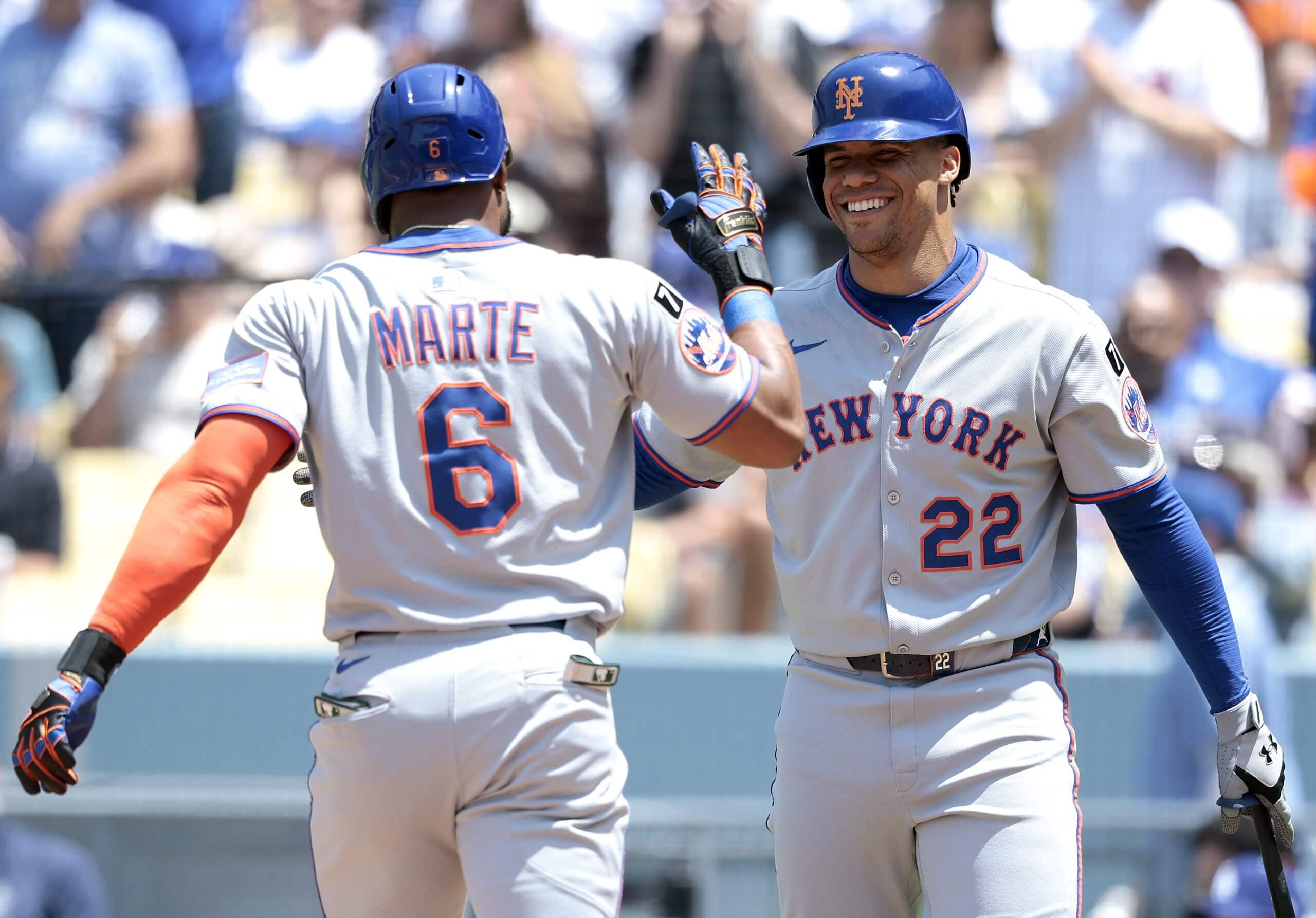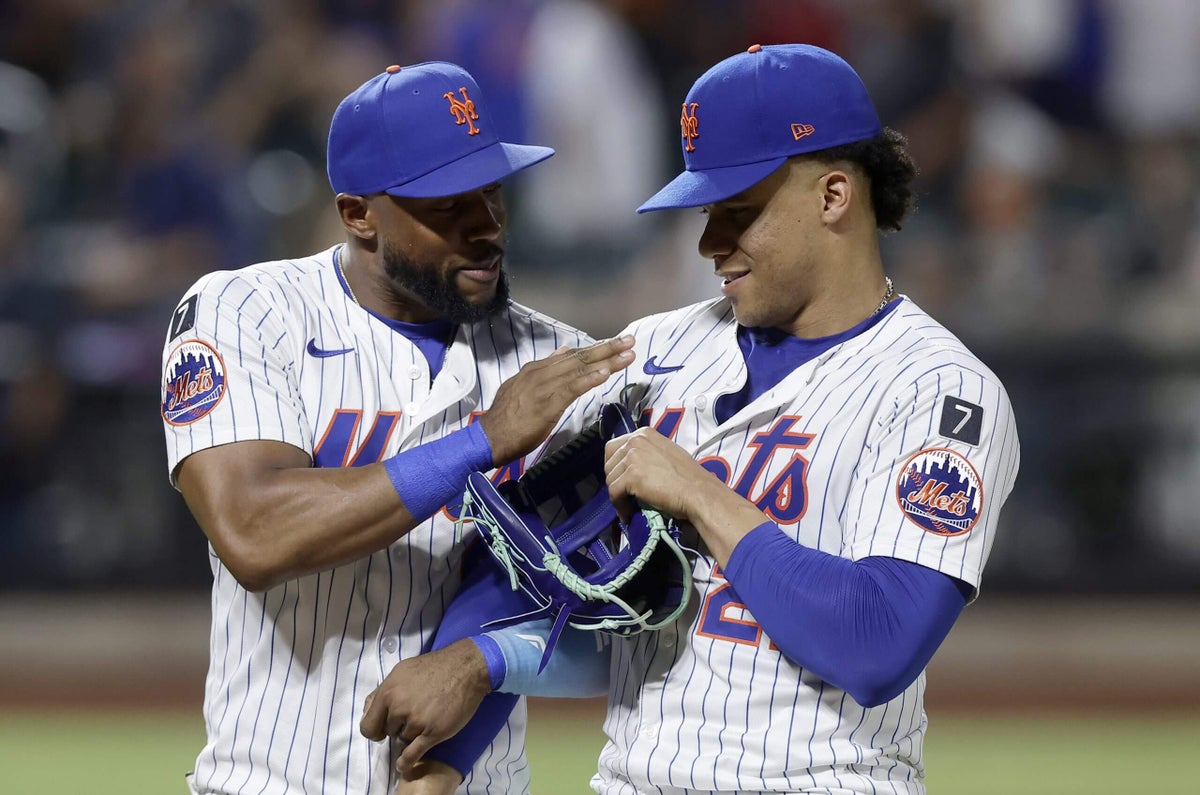Starling Marte, who turns 37 in October, finished out the four-year, $78 million contract he signed ahead of the 2022 season. After four seasons with the New York Mets, there is a distinct possibility he has played his last home game at Citi Field.
He does not want that to be the case.
“Only God knows, but with continued good health, I’d love to have the opportunity to play at least three or four more years,” Marte said in a recent interview, “and continue to be part of this team and continue to help the young guys grow.”
Will he be back? Should he be back?
After a slow start, Marte performed well this season in a limited role. In the Mets’ clubhouse, he had an outsized importance because of his experience (his 14-year major-league tenure led the team) and relationships — not just with young players but with stars like Juan Soto. Whether he is with the Mets again or not, Marte’s impact on others — including Soto, who signed a 15-year deal with New York — may endure.
“He’s a different character,” Soto said. “He is always happy. He is always willing to help everybody in this clubhouse. Since I got here, he has put me under his wing. He’s been helping me. Teaching me. Showing me a lot of things about how we do things over here, the Mets way.”
For a Mets team hounded by questions about clubhouse culture in the wake of a late-season collapse, Marte is an intriguing case.

Starling Marte served as a sounding board for stars like Juan Soto as well as for the youngest players on the roster. (Ronald Martinez / Getty Images)
It’s a few hours before a game in late summer and Marte, in a T-shirt and shorts revealing medical tape on both his knees, sits in the corner of the Mets’ clubhouse. Marte watches as assistant hitting coach Rafael Fernandez stops by the lockers, checking in with young players about times for taking on-field batting practice. On this day, Fernandez received responses lacking enthusiasm. So Marte got up.
While passing younger teammates such as Ronny Mauricio and Luisangel Acuña and walking toward the clubhouse door, Marte spoke loudly in Spanish, saying, “No, let’s go hit right now. We’re going to hit right now.”
Marte’s teammates followed him out the door.
“He is always like that,” Fernandez said. “He is ready to go. It is helpful. It is always good to have someone with experience behaving like that.”
Hearing such appreciation makes Marte smile. The Mets’ season was a failure. They were too inconsistent. They lacked “energy guys.” Marte’s steadiness, however, was an important (and perhaps rare) constant in the clubhouse and dugout, according to Soto, Pete Alonso and Francisco Lindor. It showed up during the final games of the season when he was often the only bench player who came out of the dugout between innings to meet players on the field after a poor defensive play.
Both things can be true about the Mets’ miserable season: something was perhaps missing from the clubhouse, and Marte tried to connect with different kinds of players. Especially Soto, with whom he grew close. Marte helped Soto, who carries a business-like demeanor, to fit in by encouraging him to loosen up when appropriate.
“It’s a privilege that they have that trust in me,” Marte said. “It feels good just to think that guys who one day will be future Hall of Famers took some kind of advice from me and used it for the good of the team.”
Marte’s .745 OPS and nine home runs represented his best numbers since 2022, when he was a catalyst for the Mets as their starting right fielder. Soto’s presence pushed Marte into a part-time job as a designated hitter. Through May 17, Marte’s OPS stood at just .604, but Mets manager Carlos Mendoza stuck with the veteran. Over his final 243 plate appearances, Marte hit .295 with a .795 OPS.
“It’s something different,” Marte said, “but I am still a major-league player. I try to be happy and keep it positive for the rest of the team. It is my job to do whatever role I am given. I just try to make sure that everybody is on the same page as far as feeling good and just thinking about winning.”
Mendoza and Marte had a few key conversations, including one in spring training when Mendoza outlined Marte’s role.
“Carlos is a very communicative person who is very open and tells it like it is, and I appreciate that,” Marte said.
Turns out, Marte communicates similarly.
Marte, who underwent double groin surgery ahead of the 2024 season and has since dealt with recurring knee issues, was pleased with his production. He said, however, that he was most proud of the relationships he tried to build with Mauricio, Acuña, Francisco Alvarez and other young players.
“It is very emotional to me,” Marte said. “I love to help them, see them grow. A lot of them came up together in the system, and they know each other very well. I try to speak to them a lot to help them get better, teach them more about the things that they’re doing. If they’re doing certain things that may not be the best fit for them, I try to go up to them and give them advice as to how they can improve certain things and make it better.
“And they do listen. They continuously come for advice. It is easier to relate because we speak the same language and come from the same cultures. I can come to them almost like an elderly figure and tell it like it is. I tell them the truth. And they know that the advice I am giving them is to help them improve and it is not criticism.”
Before the season, coaches remember Marte telling them he was willing to accept any role and that “I don’t know how much time I have left in the game and I just want to win.” Over time, that meant setting an example for younger players.
“Marte does not seem like a guy who will talk that much, but when he does, it’s because he has something to say,” Fernandez said. “And what I think he has done better with this year is understanding his role now more than ever.”
Mets veterans said they appreciate Marte for a few reasons. He shared information. He maintained a consistent mood. He made them laugh. He showed up and performed.
“It’s gotta be very difficult,” Lindor said of Marte seeing reduced playing time yet still producing at a solid level. “It can’t be an easy task. But he is happy. He works. He doesn’t pout. And that says a lot about who he is and how he has taken on the role.”
At times, Marte looked like an odd fit on the Mets roster (for example, Mark Vientos was another right-handed DH option). Early, he wasn’t hitting much. At the trade deadline, interest from other teams was minimal. Yet he appeared in 36 of the club’s final 50 games.
All the while, young players like Mauricio (who experienced sporadic playing time), who may be important for the Mets in future seasons, say they’ve paid attention in conversations on the bench with Marte about preparing for certain pitchers and staying ready.
“I hope it helps them a lot,” Lindor said. “I hope that they see there is a right way to do things.”
(Top photo of Starling Marte, left, and Juan Soto: Jim McIsaac / Getty Images)

